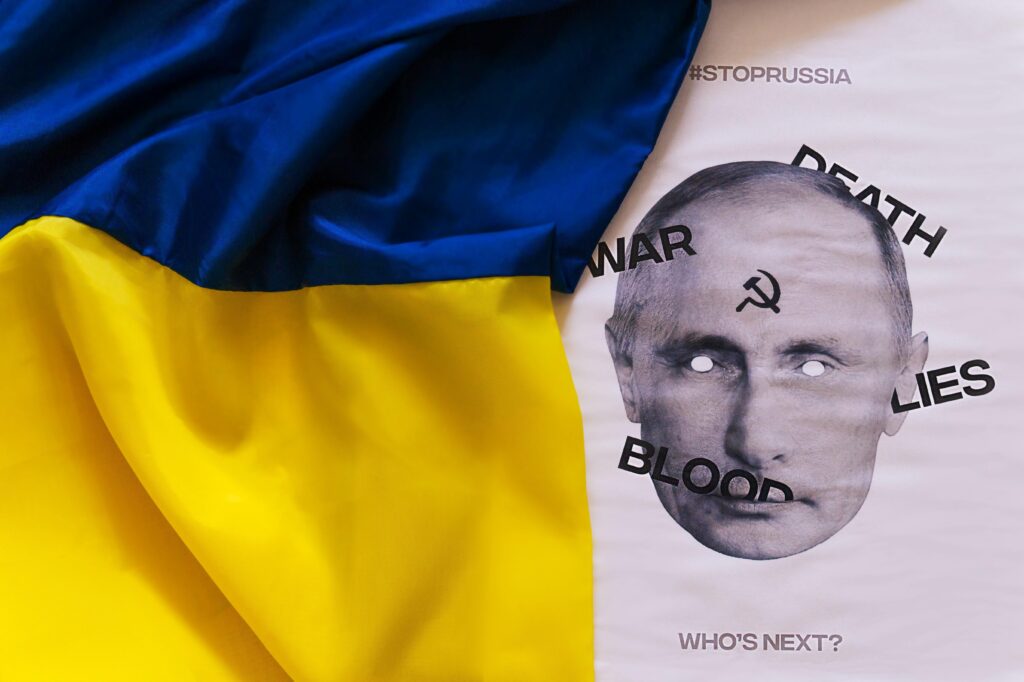Rise of the Far-Right: Too Right, Too Far Gone?

Image by Hanna Balan for Unsplash
The Russian invasion of Ukraine has had an unmitigated effect on not only far-right politics but also far-right extremism in Europe. The war continues to contribute to a change in the political landscape and affects how far-right actors are interacting with far-right politics and movements in Europe.
The Russian regime has emphasised the dangers of extreme nationalism, misinformation and far-right ideology. One of Putin’s main reasons for the invasion was to “de-nazify and fight fascism in Ukraine”. The irony in these accusations lies in Russia´s far-right ideological leanings, such as its conservative Christian centred belief system and attack on liberal and LGBTQ+ Communities. Putin himself has been hailed as a hero for white nationalists, as seen in the U.S. At one rally by the America First Political Action Conference (AFPAC) in Florida, congressmen showed support for Putin after the invasion. Nick Fuentes, a notorious anti-semite who created the AFPAC requested a “round of applause for Russia” at the white nationalist event. Overall, those tied to the extreme far-right are showing their support of Russia and Putin as the far-right approves of a more authoritarian leadership style and departure from Westernised society. One would think that this would deter the West from far-right political and ideological leanings, yet there is a continuing rise in far-right popularity in the West.
Russia has a significant history with right-wing extremism and neo-nazism. Neo nazism and far-right extremism gained traction in the late 1990s when skinhead gangs came to the forefront in a wave of racist attacks. Putin’s presidency has a track record of collaborating with neo-nazi groups like Russkii Obraz (Russian Image) and OB88, in order to combat anti-Putin and left-wing activists. There has also been more recent evidence of Russia’s ties to far-right extremism such as the links of Russian mercenaries to far-right extremists. The Wagner Group is a group of Russian mercenaries created by Dmitri Utkin, is backed by the Kremlin and first active during Russia’s annexation of Crimea in 2014. The Wagner Group has been linked to the far-right extremist and supremacist paramilitary group, the Russian Imperial Movement (RIM) which has been designated as a terrorist group in the U.S. The Wagner Group has been known to support neo nazi ideology and use hate symbols as identification on clothes and vehicles. This completely undermines Putin’s claims to ‘de-nazify’ Ukraine, considering the mercenaries “Rusich” which are seen as a subunit of The Wagner Group deployed by Russia are recognised as neo nazis known for their brutality, these far-right mercenaries are an openly fascist group which undermines Putin’s rationale for invading Ukraine.
Europe
It can be seen that far-right political candidates in Europe, particularly in France, Germany and Sweden are making a comeback whilst simultaneously trying to distance themselves from Putin for the most part. One would think that witnessing the atrocities occurring in Ukraine that anything or anyone with links to the instigators would be ostracized, instead, they are getting votes. Marine Le Pen, who has accepted funding from the Kremlin and was known to support Putin during the invasion of Crimea, is now distancing herself from Russia and Putin. Her party, National Rally (Rassemblement National), has requested that the copies of a picture of her shaking hands with Putin that were produced for her recent Presidential Campaign should be burned or binned. Far-right Italian politician Salvini, a long time supporter of Putin, visited the Polish border of Ukraine to show his support of Ukraine whilst Viktor Orban, Prime Minister of Hungary, a supporter of Putin, was forced to condemn Russian Forces and allow NATOs troops to pass through Hungary.
Germany
In Germany, far-right movements are on the rise since the 1990s. The Alternative for Germany (AfD) party in Germany has garnered support over the years and is slowly becoming a stable political force in a country in which far-right extremism and neo nazism are still a highly contentious area of discussion. Germany, like many EU countries, is experiencing a rise in tension from a multitude of sources. Germany has experienced terrorist attacks and crime from both the Islamist inspired groups such as the Berlin Christmas Market attack and far-right inspired groups. The tensions are further confounded in the last two years from the pandemic and increased restrictions and vaccinations. Germany is in a vulnerable space which is giving ground to right-wing movements. There has been a rise in arrests and raids of neo-nazi and far-right extremist groups by the police in order to combat the increasing threat posed by these groups. Even with the invasion of Ukraine, Germany is starting to see far-right groups who are pro-Russian and are becoming a significant threat. In April four members of a far-right, anti-lockdown and pro-Russian group called Vereinte Patrioten (United Patriots) had plans for violent attacks including explosives and plots to kidnap public figures including Health Minister Karl Lauterbach.
Far-right extremists are not considered to be as dangerous as Islamist Inspired extremists as they do not appear to be as lethal. Islamist Inspired attacks tend to result in more deaths on a global scale. According to the Global Terrorism Index 2022, Islamic State (IS) has overtaken as the deadliest terror group and is responsible for 29% of global terrorist deaths in 2021, but it is imperative to contextualise these statistics, as the majority of these deaths occur in areas outside of Europe. In Europe, trends are changing and far-right extremism is becoming a more substantial threat as politically motivated extremism has overtaken religiously motivated extremism. The threat of far-right extremism should not be underestimated, far-right extremism is more predominant in the West, especially in Europe. The Global Terrorism Index has consistently highlighted the growing threat of far-right extremists. A study on far-right extremism in Germany, outlined the difficulty in detecting these groups. There have been 123 far-right attacks since 1971, 70% of which were carried out by small cells comprising 2 to 9 members. The tactics range from explosives to arson to kidnapping to achieve their goals. This coincides with the Global Terrorism Index as 95% of far-left and far-right attacks are not affiliated with any particular group which is further attributed to the difficulty in statistical analysis and detection.
France
As AfD and the far-right ideology gains popularity in the German polls, a similar situation is unfolding in France as Marine le Pen went head to head with Emmanuel Macron for the Presidency. Whilst Macron attempted to appeal to the left and made promises revolving around climate change and environmental policies, Marine le Pen, known for her controversial policies, focused on anti-immigration such as deporting immigrants who face unemployment or are undocumented, and a ban on Muslims wearing the Hijab in public spaces. France is also going through a transitional period and we are seeing repeats of what was beginning in 2014-2016 in France with people turning to more far-right policies to try and combat the Islamist Inspired terror attacks which were happening at the time. France has also seen a rise in far-right ideologies in response to lockdowns and vaccines as reflected in many other areas in the world. Although Marine Le Pen has made an effort to soften her image and simultaneously distance herself from Putin she still insists on damaging rhetoric like describing the Hijab as the “Islamist uniform” and a symbol of an anti-Western interpretation of the Muslim faith. Marine Le Pen may have lost the election this time but not by much with Emmanuel Macron winning 58% to 42%.
Sweden
In the shadow of what is happening in Ukraine, we are seeing an escalation in far-right extremism and violence in countries like Sweden. In Sweden, violence broke out in response to protesters at a far-right rally, resulting in three people being injured and multiple others being arrested. This violence was in response to a far-right anti-Muslim group’s plan to rally and publicly burn the Qur’an. The clash is the second in four days after demonstrators were protesting against the rally of anti-immigration and anti-Islam group Hard Line, which is led by Rasmus Paludan, a Danish/Swedish politician. Paludan was taking a tour of Sweden to secure his place in the election. Paludan is purposely targeting communities that have a high Muslim population in order to incite backlash and burn copies of the Qur’an during the month of Ramadan. The intense backlash against Paludan and his actions was displayed in many ways, from clashes with police to burning cars. Sweden’s minister for justice called Paludan a “right-wing extremist fool” and he is only aiming to create divisions. Paludan has dual citizenship in Sweden and Denmark and since he failed to qualify for parliament in Denmark he now has his sights set on Sweden’s elections in the fall. Paludan’s extremist anti-Islam actions are deepening the divide between immigrants and society and creating chaos on which he will blame immigration and Islam.
This article is only touching the surface of a deeply complex issue, the invasion of Ukraine has had an unmitigated impact on far-right ideology and extremism in Europe, Russia continues to manipulate and utilise far-right extremism and threat of nazism to its own advantage. This use of propaganda and manipulation is further reflected in European politics as we see far-right political leaders take advantage of similar justifications for their policies, such as migration and extremism. The threat of far-right extremism is growing but is difficult to contextualize, as there is a significant dark number when it comes to statistics surrounding far-right extremism as many attacks can show as hate crimes among others. The far-right extremists’ ability to pick and choose justifications for their movements and to move seamlessly from anti-lockdown and anti-vaccine to pro-Russian/pro-Kremlin movements show that this group is subtly strengthening its foundations. The far-right extremists’ ability to capitalise on events like this in order to create movements is getting more organised and more interconnected, meaning that these groups can in some ways go undetected.
Far-right political parties staking their place and obtaining votes in countries further aggravates the threat of far-right extremism and provides a foundation for this type of extremism. This is further reflected in the fact that many far-right extremists and actors support the Ukrainian invasion.
At a time when countries and communities should be coming together, especially with the impending threat of further instability; politically, culturally and economically across the West, what we are seeing instead is the fracturing of communities and a path towards a more intense rise of far-right ideologies.


